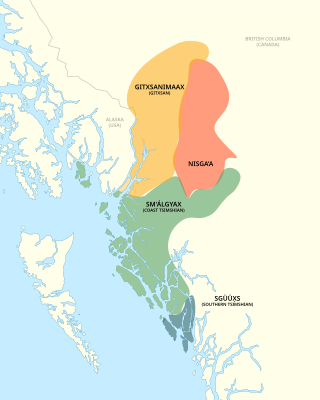| Nisga’a | |
|---|---|
| Nisg̱a’a, Nass, Nisgha, Nishka, Niska, Nishga, Nisqa’a | |
| Nisg̱a’a, nisqáʔamq | |
| Pronunciation | [nisɢaʔa] |
| Native to | Canada |
| Region | Northwest British Columbia (Nisg̱a’a Nation) |
| Ethnicity | 5,495 Nisga'a |
Native speakers | 470 (2016 census)[1] 1,500 L2 speakers[2] |
Tsimshianic
| |
| Nisg̱a’a Script (NAPA) | |
| Language codes | |
| ISO 639-3 | ncg |
| Glottolog | nisg1240 |
| ELP | Nisga'a |
 Nisga'a | |
 Nisga'a is classified as Severely Endangered by the UNESCO Atlas of the World's Languages in Danger | |
| People | Nisg̱a'a |
|---|---|
| Language | Nisg̱a'amg̱ |
| Country | Nisg̱a'a La̱xyip |
Nisga’a (also Nisg̱a’a, Nass, Nisgha, Nishka, Niska, Nishga, Nisqa’a) is an indigenous language of northwestern British Columbia. It is a part of the language family generally called Tsimshianic, although some Nisga'a people resent the precedence the term gives to Coast Tsimshian. Nisga’a is very closely related to Gitxsan. Indeed, many linguists regard Nisga’a and Gitksan as dialects of a single Nass–Gitksan language. The two are generally treated as distinct languages out of deference to the political separation of the two groups.
- ^ Nisga’a at Ethnologue (18th ed., 2015) (subscription required)
- ^ "Nisga'a". Ethnologue. Retrieved 2018-03-30.